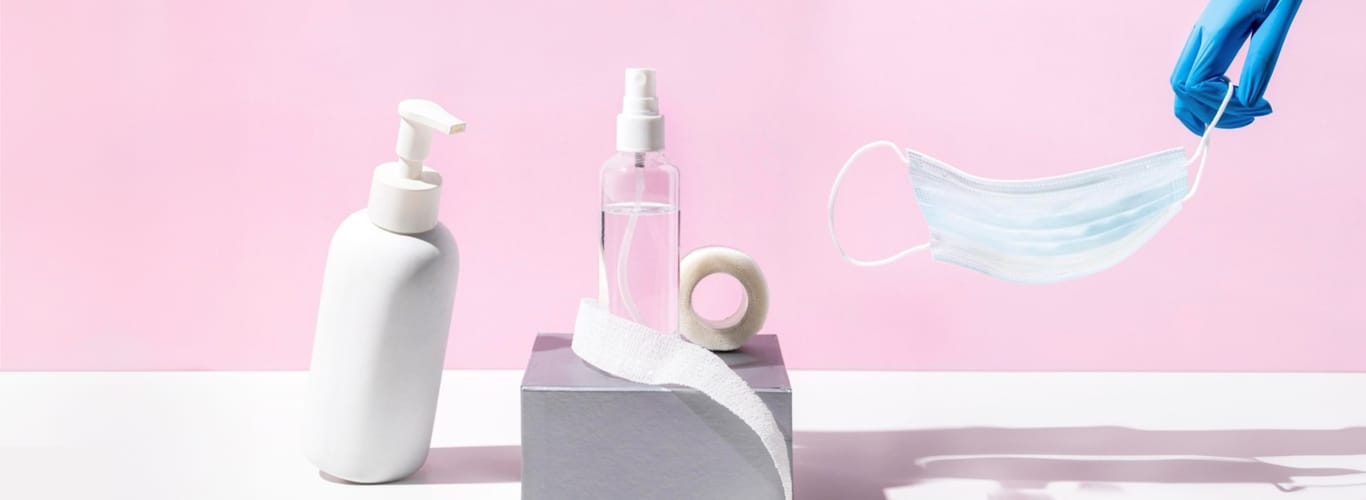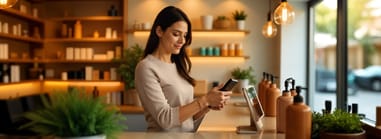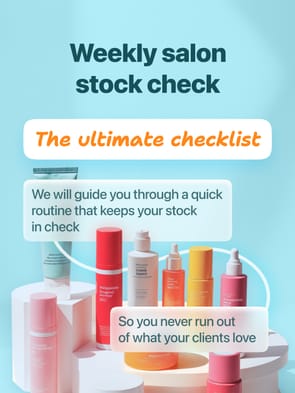The ultimate guide to salon hygiene and infection control
Loading the Text to Speech Player...
What is salon hygiene? It's a crucial aspect of the beauty industry, directly impacting client safety and business reputation. This guide delves into the essentials of maintaining a clean and safe salon environment, so you'll not only meet industry requirements but also ensure a superior experience for your clients.
Upholding standards: role of salon hygiene
In the U.S., salon hygiene is not just a matter of good practice; it's mandated by law. Strict regulations ensure cleanliness and safety in beauty salons, protecting the health of both clients and staff. These guidelines, enforced by organizations like Occupational Safety and Health Administration (OSHA), cover chemical handling, tool sterilization, and personal protective equipment.
Following these protocols not only prevents health hazards like infections and chemical exposure but also maintains the integrity of the salon industry. By adhering to legal standards, salons demonstrate their commitment to excellence, fostering trust and professionalism in the beauty realm.
So, let's delve into the essential hygiene practices that every salon should uphold!
5 general salon hygiene rules
In the heart of every successful salon lies a foundation of rigorous hygiene practices. This section outlines the key salon hygiene rules every beauty establishment must follow to ensure a safe, clean, and welcoming environment for clients and staff alike.
Spotless standards
At the core of salon hygiene is an unwavering commitment to cleanliness. Every surface, from chairs and mirrors to countertops, must be regularly sanitized. Implementing a daily cleaning schedule ensures that your salon not only looks spotless but also minimizes the risk of cross-contamination.
- Use EPA-registered disinfectants to clean surfaces and equipment.
- Pay special attention to high-touch areas like door handles, light switches, and payment terminals.
Regular deep cleaning of the salon, including floors and restrooms, further reinforces this commitment, creating an environment that is not just aesthetically pleasing but also hygienically sound.
The future of salon management
Dive into the world of automated orders and seamless warehouse accounting. Embrace the future today!
Try SupleryHands first
Hand hygiene is a non-negotiable aspect of salon safety. Both staff and clients should wash their hands thoroughly with soap and water before and after each service. This simple act is one of the most effective ways to prevent the spread of germs. Encourage the use of hand sanitizers, especially in areas where handwashing facilities are not readily available.
Nail technicians and hair stylists should make it a routine to sanitize their hands before and after each client interaction, ensuring that the risk of transferring pathogens is significantly reduced.
Tool care
Proper sterilization of tools and equipment is a critical aspect of salon hygiene. All reusable tools, including scissors, combs, brushes, and nail instruments, should be cleaned and sterilized between clients. Autoclaves or UV sterilizers are effective for this purpose.
For items that cannot withstand high temperatures, use an appropriate disinfectant solution. Make sure to follow the manufacturer's instructions for both the tools and the sterilizers to ensure effective sterilization.
Вetailed look at the sterilization process and the necessary equipment
Autoclaves. An autoclave is a device that uses steam under pressure to sterilize equipment. It is the gold standard for sterilization in nail salons. The autoclave heats tools to a high temperature (usually between 250 F or 121°C and 276 F or 134°C) for a specific period, effectively killing all microorganisms.
Metal tools like nail clippers, cuticle nippers, and metal pushers are ideal candidates for autoclave sterilization.
- Ultraviolet (UV) sterilizers. UV sterilizers use ultraviolet light to disinfect tools. While not as effective as autoclaves, they are suitable for tools that cannot withstand high temperatures. UV light disrupts the DNA of bacteria and viruses, rendering them harmless.
UV sterilizers are useful for sterilizing non-metal tools and equipment like plastic cuticle pushers and some types of files.
- Chemical sterilants and disinfectants. These are liquid solutions used to sterilize tools that cannot be subjected to high temperatures. Common chemical sterilants include glutaraldehyde, formaldehyde, and hydrogen peroxide.
Submerge the tools completely in the solution for the time specified by the manufacturer. This method is suitable for items like glass files and certain pedicure tools.
- Dry heat sterilizers. Dry heat sterilizers use hot air to sterilize tools and are an alternative to autoclaves, especially for tools that might rust. The sterilizer uses high heat (usually around 320 F or 160°C) for a longer period than autoclaves.
Dry heat sterilizers suitable for metal tools and instruments that can withstand high temperatures but are prone to rust.
Regular maintenance of equipment, including replacing any worn-out or damaged tools, is essential to maintain the highest standards of hygiene.
Single-use safety
Incorporating disposable items into salon services can significantly enhance salon hygiene practices. Items like gloves, nail files, and buffers should be single-use and disposed of immediately after each client. This practice not only prevents cross-contamination but also provides clients with the assurance that their safety is being prioritized.
Ensure that disposable items are of good quality and are used in a manner that complements your salon’s hygiene protocols. Safe disposal of these items should also be practiced, with clearly marked bins for hazardous and non-hazardous waste
Chemical care
Salons use a variety of chemicals, and their safe storage and handling are vital for maintaining a safe environment or pose a risk to health. Such chemicals are also known as hazardous materials.
Hazardous materials are substances or ingredients used in products that can pose a risk to health or the environment. These materials could include toxic chemicals, irritants, allergens, or environmentally harmful compounds. The usage of such materials is often regulated to ensure consumer safety.
- Store chemicals in a well-ventilated area, away from direct sunlight and heat sources. Ensure that all containers are clearly labeled and securely closed when not in use.
- Staff should be trained in the safe handling of chemicals, including the use of personal protective equipment like gloves and masks.
- Implement a spill response plan and have material safety data sheets (MSDS) readily available for all products.
- Follow utilization recommendations.
A Safety Data Sheet (SDS), or Material Safety Data Sheet (MSDS), is a standardized document that contains crucial occupational safety and health information. The International Hazard Communication Standard (HCS) mandates it.
By adhering to these 5 general salon hygiene rules, you can foster in your space an environment that is not only aesthetically appealing but also health-conscious, ensuring the well-being of both clients and staff.
Hygiene in nail salons
Hygiene in nail salons have unique challenges and demands. Here are specific, actionable tips tailored for the distinctive environment of a nail salon:
- Avoid cross-contamination with pedicure basins. Ensure that pedicure basins are thoroughly cleaned and disinfected after each use. Implement a protocol that includes draining, cleaning with soap and water, and then using an EPA-registered disinfectant. This process is critical to prevent fungal and bacterial infections.
- Manage dust and debris. Nail filing and buffing generate a significant amount of dust. Use dust extractors or at least ensure that your salon is equipped with HEPA filters to minimize dust in the air. Regularly clean the salon to remove nail dust and debris, which can harbor harmful pathogens.
- Implement a ‘no blood, no service’ policy. If a client has an open wound or any bleeding around the nails, postpone the service until it has healed. Open wounds are susceptible to infection and can also be a source of bloodborne pathogens.
- Handle nail products safely. Some nail products contain strong chemicals. Store all products in a cool, dry, and well-ventilated area. Ensure proper labeling and keep Safety Data Sheets (SDS) accessible for reference in case of allergic reactions or chemical spills.
- Provide regular inspections of foot spas and equipment. Set a routine for inspecting foot spas and other equipment for any signs of wear and tear. Cracks or damages can harbor bacteria and become a source of contamination.
By focusing on these specific aspects, nail salons can enhance their hygiene practices, going beyond general cleanliness to address the unique requirements of nail care and ensuring a safe, hygienic experience for every client.
Order products and manage inventory effortlessly
Discover the simplicity and efficiency of managing your salon's inventory with Suplery. Sign up for free and get:
- Access to top brands. Suplery connects you with popular beauty brands, offering competitive pricing. This means your salon can provide premium products without hurting your profit margins.
- Insightful analytics. Gain valuable insights into sales trends and inventory needs, enabling informed decisions about product selection and stock levels.
- Automated inventory management. Suplery automates the tracking and reordering process, saving you time and reducing manual errors.
- Enhanced profitability. By optimizing inventory management, Suplery helps improve your salon's overall efficiency and profitability.
With Suplery, inventory management becomes a streamlined, hassle-free process, allowing you to focus more on client satisfaction and less on backend operations.
Put the ordering process in order
Save time and avoid out-of-stock issues with Suplery's intuitive inventory alerts and easy automatic ordering tool
Sign up for freeFinal thoughts
In conclusion, maintaining impeccable salon hygiene and managing inventory effectively are key pillars in building a successful beauty business. By implementing the guidelines, you can ensure a safe, efficient, and client-friendly salon environment.
Remember, a commitment to cleanliness and smart inventory management not only enhances client trust but also drives your business toward greater heights of success. Stay clean, stay organized, and thrive!
 The latest articles and industry insights delivered to your inbox
The latest articles and industry insights delivered to your inbox
Subscribe to receive a monthly digest of our most valuable resources like blog posts, whitepapers, and guides.
Oh no! We couldn’t subscribe you ☹️
Done! You've subscribed 💛
Unsubscribe anytime. Your data is stored for business-to-business communication purposes. See our Privacy policy.
Frequently asked questions
What is salon hygiene?
Salon hygiene refers to the practices and measures taken to ensure cleanliness and sanitation in beauty salons. This includes regular cleaning, sterilization of tools, and personal hygiene of staff, to prevent the spread of infections and maintain a safe environment for clients and employees.
Why is personal hygiene important in a salon?
Personal hygiene is crucial in a salon as it directly impacts the health and safety of both clients and staff. Good personal hygiene practices, such as regular hand washing and wearing clean uniforms, help prevent the spread of germs and maintain a professional and trustworthy atmosphere in the salon.
What is the most important hygiene in a beauty salon?
The most important aspect of hygiene in a beauty salon is the sterilization and disinfection of tools and equipment. This is vital for preventing cross-contamination and the spread of infections between clients. Ensuring that all tools are properly cleaned and sterilized after each use is fundamental to maintaining high hygiene standards in any salon.
Last updated on Dec 18, 2023
“What Changed” in this article? Everything. It's packed with the latest findings, the ripest data, and a fresh analysis you won't find anywhere else.
A subject-matter expert wrote the content, and reliable, official sources support it. Recent research has been incorporated to maintain relevancy and accuracy.
Key sources and research references: osha
Please share this post
Table of Contents
Upholding standards: role of salon hygiene5 general salon hygiene rulesSpotless standardsHands firstTool careВetailed look at the sterilization process and the necessary equipmentSingle-use safetyChemical careHygiene in nail salonsOrder products and manage inventory effortlesslyFinal thoughtsFrequently asked questionsCalm is a new luxury: wellness rituals reshape U.S. salons
Calm is currency. Discover how U.S. salons turn wellness rituals — from mindful touch to collagen teas — into profit and loyalty. Learn why calm, care, and connection are becoming the new competitive edge in modern beauty.
Beauty salon operations & Team management
12 min
Stress-free salon sales: train your team to recommend with confidence
Struggling to get your salon team comfortable with selling? Learn practical ways to help staff recommend products naturally, improve client experiences, and boost sales—without feeling pushy or awkward. Simple, useful tips for any salon owner.
Beauty salon operations & Team management
11 min
Reducing salon costs: effective strategies for expense management
Struggling to manage salon expenses? This article breaks down simple ways to cut costs without sacrificing quality. Find tips you can actually use to keep your salon running smoothly and profitably.
Beauty salon operations & Team management
13 min
Unlock FREE bonus material!
Get your hands on "Weekly salon stock check: the ultimate PDF checklist". Subscribe to our newsletter and receive a link to download it straight to your inbox.
Oh no! We couldn’t subscribe you ☹️
Done! We've sent a link to your Email 📨
Trusted by the best in the beauty industry.
Transform your beauty business with Suplery!
Already enjoying our expert tips? Take the next step and join Suplery to revolutionize your business operations.
Huge range of professional products
One-click checkout after first order
Automated predictive orders
Seamless inventory management
From words to action
Start working with Suplery and explore all the tools and services you need to expand your business
Get started with Suplery24/7 Support
Secure payments
Designed by industry’s experts






